Personalities
 |
 |
 |
 |
 |
 |
 |
The Vocation of Charlemagne - II
Model Ideal of Ruler in His Relations
with His Subjects
Charlemagne was from a family that for two generations had ruled the Kingdom of the Franks, which was just one among the many barbarian peoples in Europe. During his rule of the Franks, he engaged in a series of wars – more than 50 military expeditions – by which he stopped the barbarian danger. He also held the Muslim might at bay.
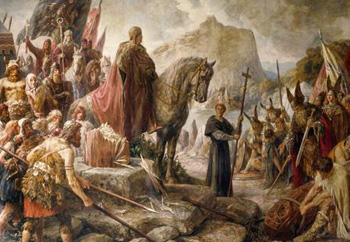 Doing this, he made History take a step backwards. That is to say, History had seemed to condemn the Latin people to disappear under the German force and the Muslim pressure. Charlemagne saved the Latin world and, by saving it, he saved Catholicity.
Doing this, he made History take a step backwards. That is to say, History had seemed to condemn the Latin people to disappear under the German force and the Muslim pressure. Charlemagne saved the Latin world and, by saving it, he saved Catholicity.
This man who did such extraordinary deeds was, according to the description of his contemporaries, a Herculean type of man. He was tall in stature, with very regular features, and conserved something of a young man in his appearance until his old age. On the other hand, when he was young he had something of the maturity of an old man. Thus, from the time he was young, he inspired respect as if he were an elder; and when he became old he aroused enthusiasm as if he were in the prime of life.
He was so amiable that legend says that when he would smile, flowers would bloom in his white beard. But in combat he was so terrible that his mere presence instilled such great fear that his enemies considered the battle already half lost.
Thus, some were so charmed by him that they would imagine flowers in his beard; others were so fearful of him that his mere presence would make them run from the battlefield. These contrasts give us an idea of the richness of his personality.
Charlemagne & his Peers
This great warrior was at the same time a great educator. He formed a group of men, which History records as the group of groups, the Twelve Peers of Charlemagne. When we speak of a Peer of Charlemagne, we refer to an ideal relationship. In the temporal order, never was the relationship between a chief and his vassals so noble, so elevated, so strong. Never was the condition of being a subject so defined and so communicative of grandeur as in a Peer of Charlemagne.
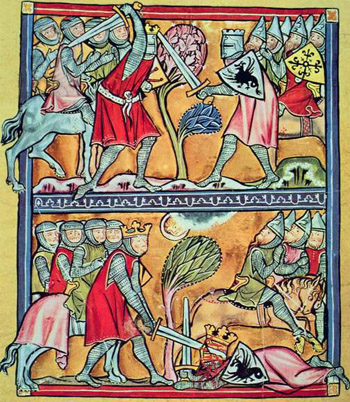 Between Charlemagne and his Peers there was a great distance. He was so strong a personage that all the Peers together were less than him. But a Peer of Charlemagne was a projection of him in such a way that he was like a son and an ambassador. He transmitted to others the personality of Charlemagne, his majesty, his strength, his grandeur…
Between Charlemagne and his Peers there was a great distance. He was so strong a personage that all the Peers together were less than him. But a Peer of Charlemagne was a projection of him in such a way that he was like a son and an ambassador. He transmitted to others the personality of Charlemagne, his majesty, his strength, his grandeur…
The Peers were like auxiliary representations of Charlemagne, even though he was inimitable. In this relationship dwells the beauty of the link that bound them to him. Charlemagne elevated his subjects to the condition of sons and, so to speak, other Charlemagnes, although they clearly remained in the position of subjects.
Further, the solidarity of those Peers was something quite beautiful. The Peers came together without megalomania, without envy, with a solidarity whose goal was to serve the Emperor, and in him, the cause of Christian Civilization and the Catholic Church.
Thus, by a whole series of mediations, they served Our Lady and Our Lord Jesus Christ in the highest Heaven. For this reason they were strongly united among themselves. The model ideal of a noble, virile, unpretentious and loyal friendship was that which united the Peers of Charlemagne.
There is a Catholic tradition by which the high nobility in all European countries took the name of Peer – Peer of the United Kingdom, Peer of France. This was in imitation of the Peers of Charlemagne, in recognition of the high perfection of the relationship of the Emperor with his Peers.
This man, who did not have a university degree, organized schools of learning throughout his whole empire, making use of intellectuals like Alcuin, a great scholar. Charlemagne had not been formed in a seminary, but his learning and renown was so great that he participated in Church councils where Bishops asked his opinion on theological questions, where he always took the orthodox stance.
His coronation
This man was the defensive wall of the Church, the glory of the Church, the son of the Church. He never stepped on the rights of the Church, but always respected her sovereignty and gave her all the power she deserved. For this reason the Church crowned him Emperor.
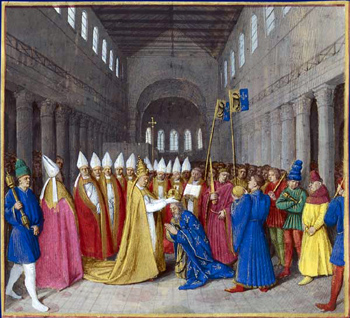 On Christmas Eve of the year 800, he was praying in the Basilica of St. John the Lateran. Pope Leo III arrived for the Mass bearing a gold crown. The Pope told Charlemagne that he wanted to restore the ruined Roman Empire by bestowing on him the title of Emperor. Charlemagne modesty refused.
On Christmas Eve of the year 800, he was praying in the Basilica of St. John the Lateran. Pope Leo III arrived for the Mass bearing a gold crown. The Pope told Charlemagne that he wanted to restore the ruined Roman Empire by bestowing on him the title of Emperor. Charlemagne modesty refused.
The Pope forced him to accept, crowned him and accompanied him to a balcony where the people acclaimed him as Emperor: “To Charles, the most pious Augustus, crowned by God, the great and peace-giving Emperor, life and victory.” Thus, the Roman Empire was restored. Under the aegis of the Catholic Church it would last more 1,000 years.
That coronation was a most beautiful papal gesture. It was the Church recognizing and crowning on earth the one whom God most likely would crown in Heaven.
Another splendid aspect of this scene is the power of the Pope. The Roman Empire was an institution that had not been born from the Popes. It was instituted by the Roman Senate. It was the Roman Senate that created the Roman grandeur. The Roman Emperors were born from the decadence of the Roman Republic. It was, therefore, a pagan institution, which was Christianized with Constantine. At that moment in History, the Pope judged himself in conditions to restore the Roman Empire. He did this and founded the Holy Roman Empire, an Empire made for the defense of the Faith.
On that Christmas night, those mysterious words of Our Lord to St. Peter in the Garden of Olives became a reality. Our Lord asked St. Peter whether he had any sword with him; St. Peter answered: “Look, Lord, there are two.” Our Lord answered: “That is enough.”
Theologians interpret these passages as St. Peter saying that he had two swords at hand: the sword of the Church, which is the power to excommunicate; and the sword of the State, which is the temporal power, the military strength to combat heresies and extirpate evil from society. These two swords are sufficient for St. Peter to fulfill his mission.
In that ceremony at St. John the Lateran, Peter was forging for himself a sword of gold, which was the Holy Roman German Empire with the mission of defending the Faith in Christendom.
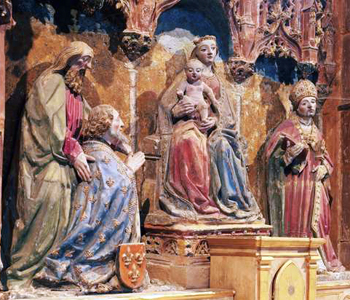 These are wonders and beauties that remind us of days very different from those in which we live. There are some ideals that never die because they are deduced directly from the Faith. They make us understand that History cannot end in a defeat of Our Lord. Revenge has to come. The Revolution has to be smashed in such a complete way that the Reign of Mary will be constituted. The world was created for this: God created everything so that in a certain era His Kingdom would be fully established over the entire world. This has to be accomplished.
These are wonders and beauties that remind us of days very different from those in which we live. There are some ideals that never die because they are deduced directly from the Faith. They make us understand that History cannot end in a defeat of Our Lord. Revenge has to come. The Revolution has to be smashed in such a complete way that the Reign of Mary will be constituted. The world was created for this: God created everything so that in a certain era His Kingdom would be fully established over the entire world. This has to be accomplished.
So, the memories of these events bring to us a hope for the future. The memory of the Empire of Charlemagne creates the hope of a different future, the certainty of a future victory. We walk toward the restoration of the order of which Charlemagne was a symbol.
We can ask Charlemagne to pray for us. Not every episode is his life is clear. The Church did not pronounce officially on whether he was a saint or not. But in certain regions of Europe there is the custom of celebrating the feast day of Blessed Charlemagne.
In the 19th century, some liberal Catholics moved by “zeal” – yes, in these matters liberals, modernists and progressivists have zeal – wanted to abolish the feast of Blessed Charlemagne. Pius IX issued a Brief in which he declared that in the places where Charlemagne was venerated as a Blessed, that devotion could continue.
We can, therefore, privately ask Charlemagne to give us the force to found the Reign of Mary, as he founded the Middle Ages, of which he was the cornerstone.
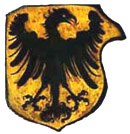

Posted September 21, 2018

Charlemagne conquering the Saxons
This man who did such extraordinary deeds was, according to the description of his contemporaries, a Herculean type of man. He was tall in stature, with very regular features, and conserved something of a young man in his appearance until his old age. On the other hand, when he was young he had something of the maturity of an old man. Thus, from the time he was young, he inspired respect as if he were an elder; and when he became old he aroused enthusiasm as if he were in the prime of life.
He was so amiable that legend says that when he would smile, flowers would bloom in his white beard. But in combat he was so terrible that his mere presence instilled such great fear that his enemies considered the battle already half lost.
Thus, some were so charmed by him that they would imagine flowers in his beard; others were so fearful of him that his mere presence would make them run from the battlefield. These contrasts give us an idea of the richness of his personality.
Charlemagne & his Peers
This great warrior was at the same time a great educator. He formed a group of men, which History records as the group of groups, the Twelve Peers of Charlemagne. When we speak of a Peer of Charlemagne, we refer to an ideal relationship. In the temporal order, never was the relationship between a chief and his vassals so noble, so elevated, so strong. Never was the condition of being a subject so defined and so communicative of grandeur as in a Peer of Charlemagne.

Charlemagne and his Peers in battle
The Peers were like auxiliary representations of Charlemagne, even though he was inimitable. In this relationship dwells the beauty of the link that bound them to him. Charlemagne elevated his subjects to the condition of sons and, so to speak, other Charlemagnes, although they clearly remained in the position of subjects.
Further, the solidarity of those Peers was something quite beautiful. The Peers came together without megalomania, without envy, with a solidarity whose goal was to serve the Emperor, and in him, the cause of Christian Civilization and the Catholic Church.
Thus, by a whole series of mediations, they served Our Lady and Our Lord Jesus Christ in the highest Heaven. For this reason they were strongly united among themselves. The model ideal of a noble, virile, unpretentious and loyal friendship was that which united the Peers of Charlemagne.
There is a Catholic tradition by which the high nobility in all European countries took the name of Peer – Peer of the United Kingdom, Peer of France. This was in imitation of the Peers of Charlemagne, in recognition of the high perfection of the relationship of the Emperor with his Peers.
This man, who did not have a university degree, organized schools of learning throughout his whole empire, making use of intellectuals like Alcuin, a great scholar. Charlemagne had not been formed in a seminary, but his learning and renown was so great that he participated in Church councils where Bishops asked his opinion on theological questions, where he always took the orthodox stance.
His coronation
This man was the defensive wall of the Church, the glory of the Church, the son of the Church. He never stepped on the rights of the Church, but always respected her sovereignty and gave her all the power she deserved. For this reason the Church crowned him Emperor.

The coronation of Charlemagne and start of the Holy Roman German Empire
The Pope forced him to accept, crowned him and accompanied him to a balcony where the people acclaimed him as Emperor: “To Charles, the most pious Augustus, crowned by God, the great and peace-giving Emperor, life and victory.” Thus, the Roman Empire was restored. Under the aegis of the Catholic Church it would last more 1,000 years.
That coronation was a most beautiful papal gesture. It was the Church recognizing and crowning on earth the one whom God most likely would crown in Heaven.
Another splendid aspect of this scene is the power of the Pope. The Roman Empire was an institution that had not been born from the Popes. It was instituted by the Roman Senate. It was the Roman Senate that created the Roman grandeur. The Roman Emperors were born from the decadence of the Roman Republic. It was, therefore, a pagan institution, which was Christianized with Constantine. At that moment in History, the Pope judged himself in conditions to restore the Roman Empire. He did this and founded the Holy Roman Empire, an Empire made for the defense of the Faith.
On that Christmas night, those mysterious words of Our Lord to St. Peter in the Garden of Olives became a reality. Our Lord asked St. Peter whether he had any sword with him; St. Peter answered: “Look, Lord, there are two.” Our Lord answered: “That is enough.”
Theologians interpret these passages as St. Peter saying that he had two swords at hand: the sword of the Church, which is the power to excommunicate; and the sword of the State, which is the temporal power, the military strength to combat heresies and extirpate evil from society. These two swords are sufficient for St. Peter to fulfill his mission.
In that ceremony at St. John the Lateran, Peter was forging for himself a sword of gold, which was the Holy Roman German Empire with the mission of defending the Faith in Christendom.

Charlemagne kneeling before Our Lady in Vezzolano Abbey, 12th c. sculpture
So, the memories of these events bring to us a hope for the future. The memory of the Empire of Charlemagne creates the hope of a different future, the certainty of a future victory. We walk toward the restoration of the order of which Charlemagne was a symbol.
We can ask Charlemagne to pray for us. Not every episode is his life is clear. The Church did not pronounce officially on whether he was a saint or not. But in certain regions of Europe there is the custom of celebrating the feast day of Blessed Charlemagne.
In the 19th century, some liberal Catholics moved by “zeal” – yes, in these matters liberals, modernists and progressivists have zeal – wanted to abolish the feast of Blessed Charlemagne. Pius IX issued a Brief in which he declared that in the places where Charlemagne was venerated as a Blessed, that devotion could continue.
We can, therefore, privately ask Charlemagne to give us the force to found the Reign of Mary, as he founded the Middle Ages, of which he was the cornerstone.


Posted September 21, 2018
______________________
______________________
 Volume I |
 Volume II |
 Volume III |
 Volume IV |
 Volume V |
 Volume VI |
 Volume VII |
 Volume VIII |
 Volume IX |
 Volume X |
 Volume XI |
 Special Edition |


